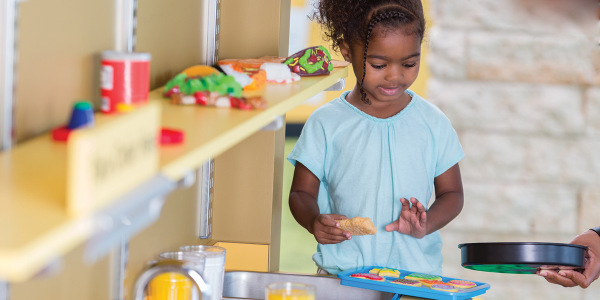Ask Hello. How Do You Use Loose Parts and Other Objects in the Dramatic Play and Kitchen Centers?

You are here
 NAEYC’s HELLO online forum is a great place to have conversations and create connections with peers around important early learning issues.
NAEYC’s HELLO online forum is a great place to have conversations and create connections with peers around important early learning issues.
Excerpts from HELLO have been edited for style and length.
Question
What are some examples of how you use loose parts in the dramatic play center or kitchen area? I’m looking to move away from commercially produced items and have more open-ended objects for the children to explore.
—Leslie, Illinois
Answers
We just discussed this in our center! One suggestion was using loose parts instead of plastic foods. You could provide rocks, glass beads, or wooden rings for children to pour, scoop, and transfer into food containers, pots, and pans.
—Elizabeth, Michigan
While keeping choking hazards in mind, loose parts are all we use in our kitchen area, and the children love them! We have tree slices, cookie-sized round rocks I purchased from a home improvement store, sweet gum pods the children collected, shells they brought in from home, small pine cones, sprigs of herbs, and some real citrus fruits like lemons and limes. Their favorite, though, might be the lids from yogurt or fruit puree pouches. They like to combine them in one bowl, mix them up, ladle them out, and call them “fruit loops.”
—Christyna, South Carolina
A few years ago, we replaced the plastic food in our indoor play kitchen with small woolen balls, wooden loops, flat wooden circles, and felt pieces cut into a variety of shapes. We store them in a three-tier hanging basket. Kitchen play has really flowered ever since. In the outdoor kitchen, children use sand from the sandbox, water, and items they gather from the yard.
—Encian, California
We use loose parts in dramatic play to foster the early literacy practice of talking and playing. The idea is to begin with “realistic” play items to give the children an initial idea of how to play and what the theme is. Then, we slowly swap out the items for open-ended playthings. For example, if you have a commercial pirate costume, it’s pretty obvious what the child is dressed up as, and no one will ask many questions. But if you have a large piece of fabric, a colander, and wide bracelets, the child can use the items to create a character from their imagination. Other children will need to ask, “What are you? Are you a space robot? A princess?” This encourages conversation and planning for dramatic play. Try offering receipt books (which can be purchased from an office supply store), pizza boxes, menus from restaurants, or pieces of plastic pipe or elbow joints (of an appropriate size with no sharp edges) from a home improvement store. Or you could simply put a good variety of boxes out for them to build with!
—Susan, Tennessee
Do you have questions or suggestions to share with your peers? Are you simply interested in reading different takes from early childhood educators around the country? Tap into the vibrant discussions on HELLO at hello.NAEYC.org/welcomehello.
